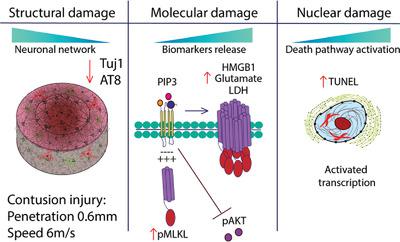当前位置:
X-MOL 学术
›
Adv. Healthcare Mater.
›
论文详情
Our official English website, www.x-mol.net, welcomes your feedback! (Note: you will need to create a separate account there.)
Modeling Controlled Cortical Impact Injury in 3D Brain-Like Tissue Cultures.
Advanced Healthcare Materials ( IF 10.0 ) Pub Date : 2020-05-13 , DOI: 10.1002/adhm.202000122 Volha Liaudanskaya 1 , Joon Yong Chung 2 , Craig Mizzoni 1 , Nicolas Rouleau 1 , Alexander N Berk 1 , Limin Wu 2 , Julia A Turner 1 , Irene Georgakoudi 1 , Michael J Whalen 2 , Thomas J F Nieland 1 , David L Kaplan 1
Advanced Healthcare Materials ( IF 10.0 ) Pub Date : 2020-05-13 , DOI: 10.1002/adhm.202000122 Volha Liaudanskaya 1 , Joon Yong Chung 2 , Craig Mizzoni 1 , Nicolas Rouleau 1 , Alexander N Berk 1 , Limin Wu 2 , Julia A Turner 1 , Irene Georgakoudi 1 , Michael J Whalen 2 , Thomas J F Nieland 1 , David L Kaplan 1
Affiliation

|
Traumatic brain injury (TBI) survivors suffer long term from mental illness, neurodegeneration, and neuroinflammation. Studies of 3D tissue models have provided new insights into the pathobiology of many brain diseases. Here, a 3D in vitro contusion model is developed consisting of mouse cortical neurons grown on a silk scaffold embedded in collagen and used outcomes from an in vivo model for benchmarking. Molecular, cellular, and network events are characterized in response to controlled cortical impact (CCI). In this model, CCI induces degradation of neural network structure and function and release of glutamate, which are associated with the expression of programmed necrosis marker phosphorylated Mixed Lineage Kinase Domain Like Pseudokinase (pMLKL). Neurodegeneration is observed first in the directly impacted area and it subsequently spreads over time in 3D space. CCI reduces phosphorylated protein kinase B (pAKT) and Glycogen synthase kinase 3 beta (GSK3β ) in neurons in vitro and in vivo, but discordant responses are observed in phosphprylated ribosomal S6 kinase (pS6) and phosphorylated Tau (pTau) expression. In summary, the 3D brain‐like culture system mimicked many aspects of in vivo responses to CCI, providing evidence that the model can be used to study the molecular, cellular, and functional sequelae of TBI, opening up new possibilities for discovery of therapeutics.
中文翻译:

在类似3D的大脑组织培养中对受控的皮质撞击损伤进行建模。
颅脑外伤(TBI)幸存者长期遭受精神疾病,神经退行性变和神经发炎的困扰。3D组织模型的研究为许多脑部疾病的病理生物学提供了新见识。在这里,开发了一个3D体外挫伤模型,该模型由生长在嵌入胶原蛋白的丝支架上的小鼠皮质神经元组成,并将体内模型的结果用于基准测试。分子,细胞和网络事件的特征在于对受控皮质撞击(CCI)的响应。在此模型中,CCI诱导神经网络结构和功能的降解以及谷氨酸的释放,这与程序化的坏死标记磷酸化的混合谱系激酶结构域(如假激酶)的表达有关。首先在直接受影响的区域观察到神经变性,随后神经变性在3D空间中随时间扩散。CCI可降低磷酸化蛋白激酶B(pAKT)和糖原合酶激酶3 beta(GSK3β)在体外和体内神经元中,但在磷酸化核糖体S6激酶(pS6)和磷酸化Tau(pTau)表达中观察到不一致的反应。总之,类似于大脑的3D培养系统模仿了体内对CCI的反应的许多方面,提供了该模型可用于研究TBI的分子,细胞和功能后遗症的证据,为发现治疗方法开辟了新的可能性。
更新日期:2020-06-24
中文翻译:

在类似3D的大脑组织培养中对受控的皮质撞击损伤进行建模。
颅脑外伤(TBI)幸存者长期遭受精神疾病,神经退行性变和神经发炎的困扰。3D组织模型的研究为许多脑部疾病的病理生物学提供了新见识。在这里,开发了一个3D体外挫伤模型,该模型由生长在嵌入胶原蛋白的丝支架上的小鼠皮质神经元组成,并将体内模型的结果用于基准测试。分子,细胞和网络事件的特征在于对受控皮质撞击(CCI)的响应。在此模型中,CCI诱导神经网络结构和功能的降解以及谷氨酸的释放,这与程序化的坏死标记磷酸化的混合谱系激酶结构域(如假激酶)的表达有关。首先在直接受影响的区域观察到神经变性,随后神经变性在3D空间中随时间扩散。CCI可降低磷酸化蛋白激酶B(pAKT)和糖原合酶激酶3 beta(GSK3β)在体外和体内神经元中,但在磷酸化核糖体S6激酶(pS6)和磷酸化Tau(pTau)表达中观察到不一致的反应。总之,类似于大脑的3D培养系统模仿了体内对CCI的反应的许多方面,提供了该模型可用于研究TBI的分子,细胞和功能后遗症的证据,为发现治疗方法开辟了新的可能性。



























 京公网安备 11010802027423号
京公网安备 11010802027423号